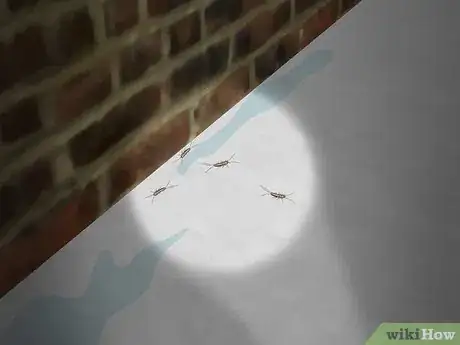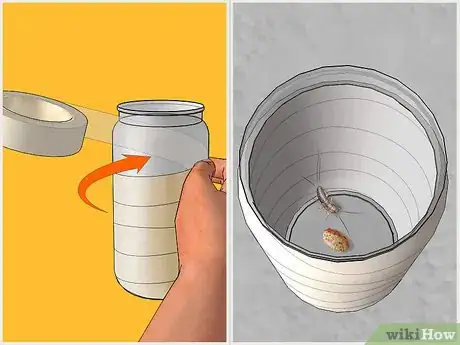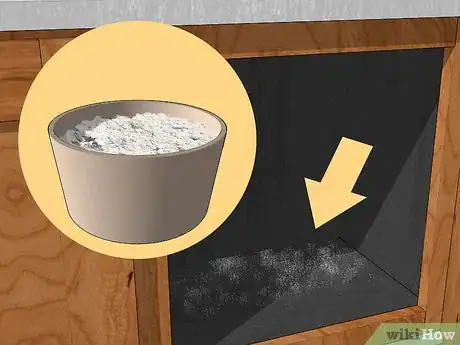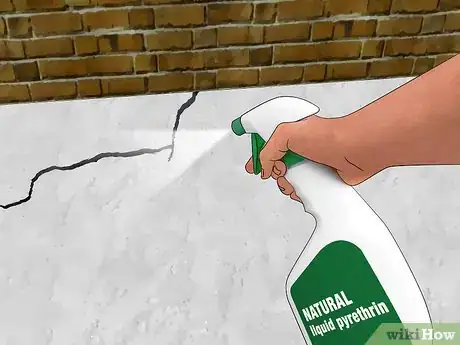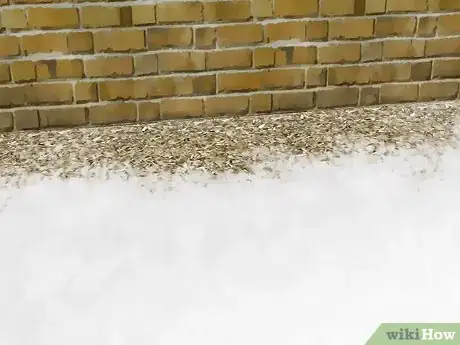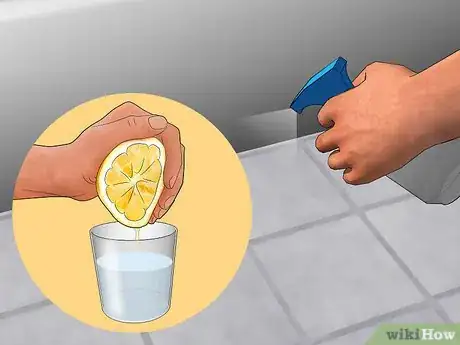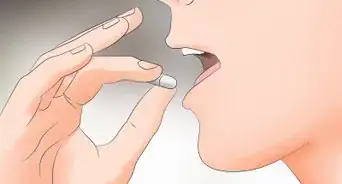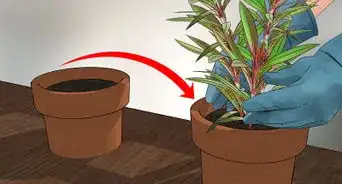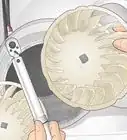This article was co-authored by Elmer Bensinger. Elmer Bensinger is a Pest Control Specialist with Eden Advanced Pest Technologies in Spokane, Washington. With over 20 years of experience, Elmer specializes in integrated pest management and products such as insecticides and rodenticides. He studied business at South Puget Sound Community College.
wikiHow marks an article as reader-approved once it receives enough positive feedback. This article received 82 testimonials and 92% of readers who voted found it helpful, earning it our reader-approved status.
This article has been viewed 3,311,033 times.
Silverfish are fairly harmless, but these grayish-blue, serpentine creatures aren't pleasant to have around the house. They feed on books, dead skin cells, and other starchy materials and thrive in dark, wet spaces. Once you've determined you have an infestation, you can get rid of silverfish by trapping them, repelling them, killing them with insecticides, or making your home less hospitable. There are plenty of options to try, so be aware that you may have to experiment and implement several techniques to completely fix your silverfish problem.
Household Solutions
If you're dealing with a silverfish infestation, you may be able to handle it without calling the exterminators, using products found around your house:
- Use a mason jar, masking tape, and bread to make a simple trap.
- Use old newspapers to make quick, inexpensive traps.
- Sprinkle diatomaceous earth to kill silverfish on contact.
Steps
Trapping Silverfish
-
1Figure out where they're lurking. Since silverfish are nocturnal, you may not see them during the day. Rather, you'll probably become aware of their presence because of what they leave behind. Look for damp, dark areas with small spots of excrement that look like black pepper. Small holes and yellowish stains on clothing, wallpaper, cereal boxes, and other cardboard or fabric materials also indicate they're nearby. Finally, silverfish shed their skin, so you can look around for tiny skin casts in your bathroom, basement and other areas where you suspect they live.[1]
-
2Set out homemade glass silverfish traps. Take a quart-sized mason jar or another glass container. Wrap the outside of the container with a piece of masking tape. Place a piece of bread at the bottom of the glass. Set the glass in an area where you suspect silverfish reside. Make sure to wrap tape all the way to the top. The silverfish will climb into the glass to eat the bread, but they'll be unable to get back out, since the glass is too slippery.[2]
- Use the traps at night, when silverfish come out to feed.
Advertisement -
3Try newspaper traps. Roll up a newspaper, band the ends with elastic, and moisten it. Set it out where you often see silverfish leavings before you go to bed. In the morning, silverfish will have eaten their way into the newspaper, since you've provided them with both food and a cozy environment.[3] Throw the newspapers away (without unrolling them) or burn them. Repeat every night until you don't see any more signs of silverfish.[4]
- Make as many traps as necessary to trap the silverfish in your home. Depending on the severity of your infestation, you may need to set them out several nights in a row.
-
4Use store-bought traps. If you don't want silverfish touching your glassware, you can buy traps designed to catch them from a hardware store. Any type of sticky traps will work. Buy some "roach motels" or smaller traps you can set around to catch the silverfish. You can bait them with small pieces of bread or another starch.
Using Repellents and Insecticides
-
1Sprinkle diatomaceous earth in cabinets and other dark areas. This powdery substance is actually food-grade, and it's used to kill anything that crawls. It's made out of ground-up fossilized material, and the sharp edges of each individual grain puncture insects' exoskeletons and cause them to die without causing any harm to humans or pets.
- Sprinkle the substance in your cabinets, along baseboards, and anywhere else you'd like before you go to bed. In the morning, vacuum up the powder (and along with it, the silverfish).
- Wear a mask when you're sprinkling the powder, since it can irritate your lungs.
-
2Try boric acid. This is another natural substance that kills both silverfish and their eggs. Sprinkle it along baseboards, under the bathtub, and in other areas where you see silverfish signs. Be careful not to inhale boric acid when you apply it, since it's toxic to the lungs. Avoid using it where your household pets might get into it, too.
- An effective product for silverfish prevention is Dekko Silverfish Paks which contain boric acid as the active ingredient.
-
3Buy a chemical spray containing liquid pyrethrin.[5] This chemical kills silverfish when you spray it along baseboards and into cracks, as well as other places where silverfish lurk. Do not apply this in your kitchen cabinets or near food sources, and don't apply it where children and pets hang out, since it's toxic.
-
4Sprinkle cedar shavings where they live. Silverfish are repelled by the smell of cedar, so you can keep them away by sprinkling it around areas where they live.[6] Since cedar shavings can make a bit of a mess, use them in outdoor areas, basements, and other places where you don't mind having wood shavings lying around. Vacuum them up and replace them every week or so.
-
5
-
6Use a citrus or lavender spray. Both of these scents are also effective in repelling silverfish, and they're completely nontoxic to humans, of course.[8] Get some lemon or lavender essential oil from a health food store. Dilute with water and shake the solution up in a spray bottle and spray liberally in all areas where you don't want silverfish. These sprays are great for closets, drawers, and other bedroom areas.
Preventing Silverfish from Returning
-
1Dehumidify your home. Since silverfish love damp places, reducing the humidity in your home is a sure way to keep them out.[9] Buy a dehumidifier and try to reduce the humidity in your home. If you don't want to use a dehumidifier, run the air conditioner or at least keep the fans on.
-
2Caulk all cracks and crevices where they could lay eggs. If your house is full of dark, damp cracks and crevices, filling these is a good way to keep silverfish out. Buy some caulk and apply it along baseboards, inside cracks, and in holes in your wall or floor. This is particularly important to do in your kitchen, bathroom and basement.
-
3Remove clutter and food sources from your house. Keeping your floor clear of silverfish food may help keep their population down. Don't leave a pile of books on the floor, and clean up your dirty laundry before it sits there too long.[10] In addition to these primary food sources, consider the following sources that may be a factor:
- Cardboard boxes. Store your boxes on shelves instead of the floor, where they're more likely to get damp.
- Food containers. Keep your food in sealed plastic containers instead of boxes.
- Wallpaper. If you've got old wallpaper, consider replacing it with paint or new wallpaper.
- Old clothing. If you store your out-of-season clothing in your basement or a dark closet, consider placing it in plastic bags to keep the silverfish out.
-
4Vacuum your house often. Vacuuming helps to keep their food sources down and sucks eggs out of the carpet and baseboards. Vacuum at least once a week. When necessary, you can dry out your carpets by sprinkling them with baking soda, leaving it for a few hours, then vacuuming it up. This dries out the eggs so you can suck them up.
Community Q&A
-
QuestionI'm finding silverfish in my bathroom sink. Why and how do I stop them from coming in?
 Community AnswerSilverfish sometimes breed down drains due to the moisture. After using the sink before you go to bed, pour a cap of bleach down all sinks and drains in the house and, if possible, plug them. This should prevent them from reproducing.
Community AnswerSilverfish sometimes breed down drains due to the moisture. After using the sink before you go to bed, pour a cap of bleach down all sinks and drains in the house and, if possible, plug them. This should prevent them from reproducing. -
QuestionDo silverfish live outside?
 Mr. CCommunity AnswerYes, they do live outside. Many times they can be found under rocks or tree bark, or in and around dead leaves.
Mr. CCommunity AnswerYes, they do live outside. Many times they can be found under rocks or tree bark, or in and around dead leaves. -
QuestionHow do silverfish get into the house?
 Community AnswerThey can come in through open doors, windows, pipes and any cracks in the walls.
Community AnswerThey can come in through open doors, windows, pipes and any cracks in the walls.
Warnings
- Be careful using chemicals; some may harm your family and pets if they ingest or inhale them. Be sure to check safety precautions and warnings labels before using and follow the directions for use.⧼thumbs_response⧽
References
- ↑ http://pestkill.org/insect/bugs/silverfish/
- ↑ https://pesthacks.com/how-to-get-rid-of-silverfish/
- ↑ https://pesthacks.com/how-to-get-rid-of-silverfish/
- ↑ http://pestkill.org/insect/bugs/silverfish/
- ↑ https://www.bobvila.com/articles/how-to-get-rid-of-silverfish/
- ↑ https://pesthacks.com/prevent-silverfish-works-doesnt/
- ↑ https://pesthacks.com/prevent-silverfish-works-doesnt/
- ↑ https://pesthacks.com/prevent-silverfish-works-doesnt/
- ↑ https://texasinsects.tamu.edu/silverfish/
About This Article
To get rid of silverfish, vacuum your home thoroughly to remove eggs that might be hiding in carpets, floorboards, and hard-to-reach corners and crevices. For an easy, non-toxic way to kill silverfish, sprinkle some diatomaceous earth in places where you’ve seen them, like under the sink, in the basement, and in the back of cabinets. Diatomaceous earth is a powder that will dry out and kill silverfish when they come into contact with it. Though it is non-toxic, make sure to keep it away from children and pets. Place commercial silverfish traps throughout your home to catch even more silverfish. To prevent silverfish from entering your home, seal up any cracks around doors and windows with caulk. Use a dehumidifier if your home is humid since silverfish thrive in wet environments. You should also keep dry foods like pasta, rice, and cereal in sealed containers to cut off their food source. Finally, remove any stacks of papers, books, or magazines around your home since silverfish like to hide in them. To learn more silverfish prevention techniques, keep reading below!
